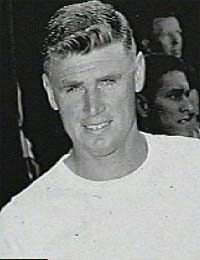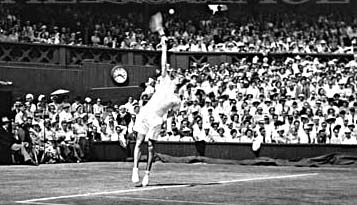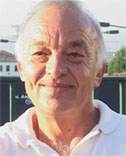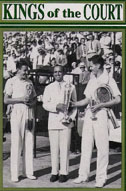Frank Sedgman:
Best of All Australians?
By Ed Atkinson
 |
The Golden Boy: less well known to history than to his own era. |
At the middle of the 20th century, the Los Angeles Tennis club was the cradle of the tennis world, the home of Bobby Riggs and Jack Kramer, and all the great Americans that went before them.
But, the winds of revolution were blowing, winds that were about to sweep over the Americans and the world. Winds coming from Australia.
Harry Hopman the Australian Davis Cup captain scoured his country looking for superior young athletes he could mold into tennis players. It was a system that would change the balance of power in the world of tennis. Rod Laver, Ken Rosewall, and Lew Hoad, were a few of these players he discovered.
But the first king from this new royal house would be Frank Sedgman. The Aussies named him Golden Boy. His demeanor, athleticism, good looks and consummate all-court game combined to make him the quintessential champion.
Today he is far less known than other Australian players such as Lew Hoad, even though he won more Grand Slam titles. (5 total Slam titles for Segdman, versus 4 for Hoad.) But in his day he was recognized as a champion who, at his best, played at the highest level tennis of all his contemporaries, with a pure serve and volley style.
Bobby Riggs, for one, is on record saying that Frank Sedgman may have been the greatest of all the Australians. Said Riggs, "He had a very similar game to Jack Kramer, only he was twice as fast, and a better volleyer."
"The minute he could get to the net, he would get up there, because he was such a good volleyer."
He was one of a number of Australian players who used the Continental grip on both sides for groundstrokes. He had a very good, serve, a very good overhead, and besides his wonderful all-around game, was also known as a wonderful sportsman.
Sedgman won 5 Grand Slam singles titles in the late 1940's and early 1950s. These included two Australians, two U.S. Championships, and one Wimbldeon crown.
But his doubles record was even more impressive. Over the same period, he Sedgman won 17 total Grand Slam titles, in mens and mixed doubles. So his total was 22 Grand Slam titles overall before turning pro at the top of his game in 1953.
Sedgman and his partner Ken McGregor were the only men's doubles team to ever win the Grand Slam in a single year--they won all four majors in 1951. The following year they also won the first three majors, but at Forest Hills, were upset by another Australian, Mervyn Rose, and an American, Vic Seixas. According to Rose, Harry Hopman, the coach of the Australian Davis Cup team, wouldn't talk to him for two months afterwards.
 |
Wimbledon and 4 other Grand Slam titles. |
He also led Australia to 3 straight Davis Cup victories in 1950, 1951, and 1952, kicking off two decades of down under dominance under Captain Harry Hopman.
A big part of Sedgman's success was due to his speed and movement. Jack Kramer called Sedgman, "One of the quickest people ever to play the game of tennis. He could hit a first volley from anywhere, a low or high volley, and then move in. I think he was as fast as Fred Perry. But what I loved most about Frank is he'd had no quit in him."
Pancho Segura described how Sedgman would play further back around the midcourt on his volley than other serve and volleyers. "He didn't mind half volleying. After he served, he'd wander in, almost in no man's land, and then he would pick up these amazing half volleys, forehand or backhand. Then suddenly he'd be at the net and lunging for the next shot."
In 1953 Sedgman turned pro and was, possibly, on his way to defeating the reigning king of the game, Jack Kramer. After 35 matches Sedgman was ahead 18-17. But Sedgman injured his shoulder, then caught the flu, and Kramer won 17 of the next 19 matches. After Sedman recovered, they split the remaining 42 matches, each winning another 21. Kramer therefore ended up winning the tour 55-41.
It was the closest Kramer came to losing an annual tour. According to Kramer, his second serve was the difference. "He couldn't handle my second serve, and at the end, that was what saved me." Other observers thought it would have gone differently if Frank had stayed completely healthy.
Sedgman went on to win three professional tennis tourney titles, and continued to play professionally well into the 1960s. Then at the age of 45, he dominated the first grand masters tour.
He was known as a gentleman, but also had another reputation, for being extremely frugal, like a number of other Australian players of the same era. An Australian radio reporter once asked Pancho Segura what his single biggest thrill in tennis had been. "The night Frank Sedgman bought dinner," Segura replied.
Sedgman's career at the majors was cut short, like so many other top players, by his move into professional play. This has made him less well known to tennis history, and the full extent of his potential domiance and ability to win numerous additional Grand Slam titles will remain a question of tantilizing speculation.





